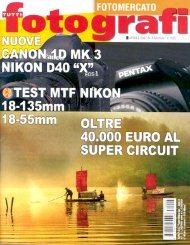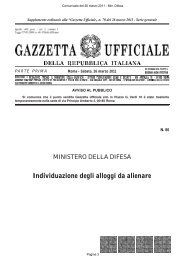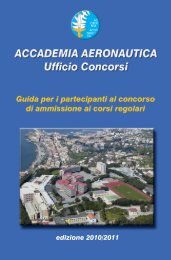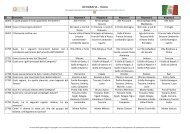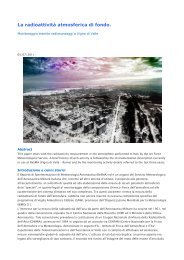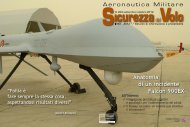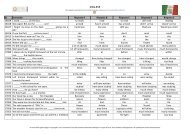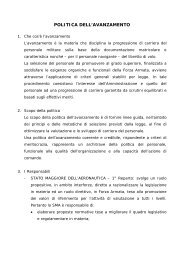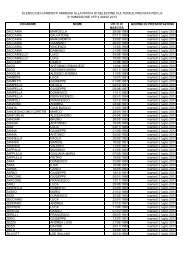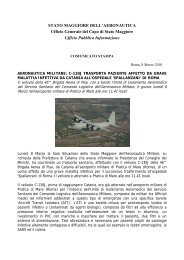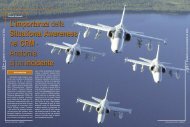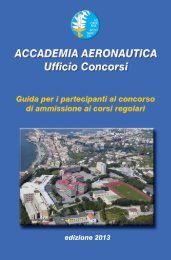Scarica l'intera rivista in formato pdf - Aeronautica Militare Italiana
Scarica l'intera rivista in formato pdf - Aeronautica Militare Italiana
Scarica l'intera rivista in formato pdf - Aeronautica Militare Italiana
You also want an ePaper? Increase the reach of your titles
YUMPU automatically turns print PDFs into web optimized ePapers that Google loves.
Attività di Prevenzione nel Controllo Spazio Aereo<br />
Human Factor<br />
nella prevenzione delle<br />
Runway<br />
Cap. Marco Nardella<br />
Incursions<br />
Lo studio degli <strong>in</strong>cidenti aeronautici sotto l’aspetto<br />
del fattore umano permette di comprendere<br />
a pieno le d<strong>in</strong>amiche che causano i s<strong>in</strong>istri ed il più<br />
delle volte gli errori commessi celano vere e proprie<br />
falle all’<strong>in</strong>terno delle organizzazioni che operano <strong>in</strong><br />
campo aeronautico. E’ il caso, ad esempio, dell’<strong>in</strong>cidente<br />
di Tenerife del 1977, il più grave nella storia<br />
dell’aviazione, <strong>in</strong> cui la collisione <strong>in</strong> pista di due<br />
Boe<strong>in</strong>g 747 causò la morte di 583 persone, o per<br />
quanto ci ha co<strong>in</strong>volto direttamente, il disastro di<br />
Milano L<strong>in</strong>ate dell’8 ottobre 2001, che vide due velivoli<br />
scontrarsi <strong>in</strong> pista e 118 persone perdere la vita.<br />
Queste tipologie di <strong>in</strong>cidenti sono il risultato più tragico<br />
delle cosiddette “Runway Incursions” (RI), che<br />
l’ICAO, nel Doc 4444, def<strong>in</strong>isce come “qualsiasi<br />
accadimento <strong>in</strong> un aeroporto che comporti la presenza<br />
non corretta di un aeromobile, veicolo o persona<br />
nell’area protetta comprendente la superficie<br />
dest<strong>in</strong>ata all’atterraggio ed al decollo degli aeromobili<br />
stessi”. Per favorire l’analisi metodologica sulla<br />
base dei pr<strong>in</strong>cipi di safety analysis e di risk assessment,<br />
secondo il Doc. 9870 ICAO le RI vengono classificate<br />
<strong>in</strong> 5 categorie, <strong>in</strong> funzione della severità<br />
progressiva del rischio:<br />
A. Serious <strong>in</strong>cident: evento associato a circostanze<br />
che <strong>in</strong>dicano che un <strong>in</strong>cidente sarebbe potuto<br />
facilmente accadere (la separazione dim<strong>in</strong>uisce<br />
ed i protagonisti applicano un’estrema azione<br />
correttiva per evitare la collisione);<br />
B. Major <strong>in</strong>cident: evento associato a circostanze<br />
che <strong>in</strong>dicano che la sicurezza potrebbe essere<br />
stata compromessa (la separazione dim<strong>in</strong>uisce<br />
ed esiste la probabilità di collisione);<br />
“Human Factor <strong>in</strong> Runway Incursions Prevention”<br />
Study<strong>in</strong>g aviation accidents, focus<strong>in</strong>g on human<br />
factor aspects, allows to fully understand the dynamics<br />
that cause accidents and most of the times<br />
mistakes conceal real flaws with<strong>in</strong> organizations operat<strong>in</strong>g<br />
<strong>in</strong> the field of aeronautics. It is the case, for<br />
example, of the Tenerife event <strong>in</strong> 1977, the most<br />
serious <strong>in</strong> the history of aviation, where the collision<br />
of two Boe<strong>in</strong>g 747 on the runway caused the death of<br />
583 people, or the disaster at Milan L<strong>in</strong>ate on October<br />
8th 2001, s<strong>in</strong>ce it has a more direct <strong>in</strong>volvement,<br />
which saw the two aircraft collide on the runway and<br />
118 people lost their lives. These types of accidents<br />
are the most tragic result of the so called "runway<br />
<strong>in</strong>cursions" (RI), which ICAO def<strong>in</strong>es <strong>in</strong> Doc 4444 as<br />
"any occurrence at an airport <strong>in</strong>volv<strong>in</strong>g the <strong>in</strong>correct<br />
presence of an aircraft, vehicle or person <strong>in</strong> the protected<br />
area <strong>in</strong>clud<strong>in</strong>g the area used for land<strong>in</strong>g and<br />
take-off of aircraft". In order to facilitate the methodological<br />
analysis based on the pr<strong>in</strong>ciples of safety<br />
analysis and risk assessment, accord<strong>in</strong>g to the ICAO<br />
Doc 9870 RI are classified <strong>in</strong>to five categories, depend<strong>in</strong>g<br />
on the <strong>in</strong>creas<strong>in</strong>g severity of the risk:<br />
A. Serious <strong>in</strong>cident: an event associated with circumstances<br />
<strong>in</strong>dicat<strong>in</strong>g that an accident could<br />
easily happen (the separation decreases and<br />
the protagonists apply extreme corrective<br />
action to avoid a collision);<br />
B. Major <strong>in</strong>cident: an event associated with circumstances<br />
<strong>in</strong>dicat<strong>in</strong>g that security may have<br />
been compromised (the separation decreases<br />
and there is a likelihood of a collision);<br />
2<br />
Rivista n° 294/2012<br />
3



